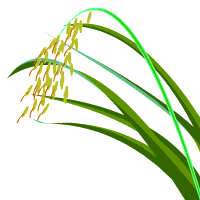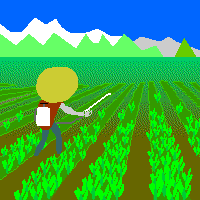Home » Tokyo Food Safety Information Center » Good things to know » Pesticide residue » About limits for pesticide residue on agricultural products
About limits for pesticide residue on agricultural products
Introduction
In modern agriculture, pesticides are essential in preventing damage from disease and harmful insects and achieving stable harvests, as well as for reducing the labor required of farmers. Conversely, however, the dissemination of pesticides has also caused problems such as harm to human health, environmental pollution of soils and rivers, and residue on agricultural products.
What are pesticides? What kind of pesticides are there? And how are pesticides regulated? How are pesticides actually used?
History of pesticides
The history of pesticides in Japan extends all the way back to the Edo period. During this time period, oils such as whale oil were poured into rice paddies to block the spiracles insects use to breathe and suffocate them to death. In the Meiji period, natural Dalmatian chrysanthemums and nicotine were used to combat insects, while in the Taisho period, people used the mineral lead arsenate.
Abroad, the Bordeaux mixture, copper sulfate and lime dissolved in water, was developed in France in 1885, and this was widely used to control the disease carrying pests of fruit trees and vegetable plants.
Modern chemically synthesized compounds began to be used in earnest in agriculture after the Second World War.

What are pesticides?
Pesticides are agents used in agriculture and forestry, such as bactericides, insecticides, and herbicides used to control disease carrying insects and weeds, as well as agricultural product growth regulators. In addition to chemical agents, there are also pesticides made by artificially growing plants and bacteria which are the natural enemies of harmful insects. Some of the insecticides and bactericides people use in their gardens at home contain the same substances as used in certain pesticides, but these are not classified as pesticides themselves.
It is important to use the right pesticides for the right purposes, and in the right amounts. All pesticides sold and used in Japan must be registered by the Minister of Agriculture, Forestry and Fisheries based on the Agricultural Chemicals Control Act. When seeking registration, data must be submitted concerning environmental safety standards such as the effects of the agricultural chemical, safety testing, soil persistence, toxicity to aquatic animals and plants, water pollution; the agricultural chemical must also undergo a government investigation.
Types of pesticides
There are many types of pesticides, and they are categorized by their usages, forms, and types of active ingredients.
Categories by usage
Pesticides are categorized by their usage per the following.
| Type | Usage |
|---|---|
| Insecticide | Control harmful insects. |
| Bactericide | Control bacteria and molds which cause diseases, etc. |
| Herbicides | Control weeds which have harmful effects on agricultural products. |
| Plant growth regulators | Control agricultural product development and flowering. |
| Attractants | Attract harmful insects using a stimulus such as a specific scent for extermination. |
| Spreading agents | Help chemicals adhere to plants and the bodies of harmful insects. |
Categories by active ingredient type
Pesticides can be categorized by their active ingredients.
| Type | Primary pesticides |
|---|---|
| Organochlorine | Iprodione, Captan, Chlorothalonil, Dicofol, Dieldrin, Procymidone, BHC, DDT |
| Organophosphate | Chlorpyrifos, Dimethoate, Diazinon, Parathion, Fenitrothion, Malathion, EPN |
| Organosulfur | Ziram, Maneb |
| Carbamate | Carbaryl, Pirimicarb, Methomyl |
| Pyrethroid | Permethrin, Fenvalerate |
| Phenoxy | 2,4-D |
| Others | Bromine, Imazalil, Bitertanol |
| Antibiotics | Kasugamycin, Streptomycin, Polyoxin |
| Natural chemicals | Pyrethrins, Lead arsenate, Nicotine |
Categories by chemical form
Surfactants and solvents are added to active ingredients as auxiliary materials in pesticides as appropriate to their purpose of use to sell them as formulations in easy to use forms. Examples include powders, granules, emulsions, liquids, water soluble agents, smoking agents, and aerosols.
These pesticides are used via methods such as ground application, soil application, aerial application, and in-building application.
